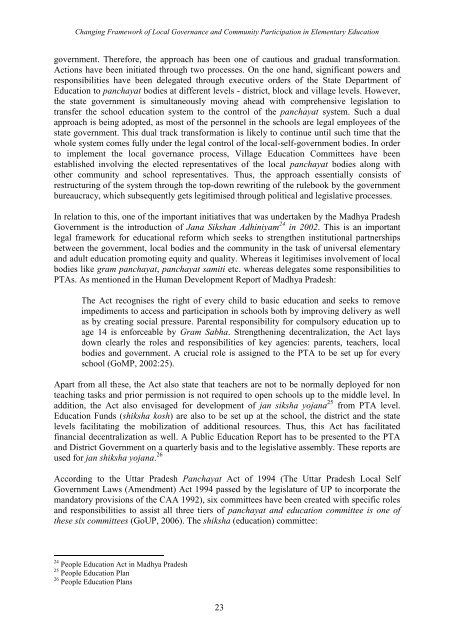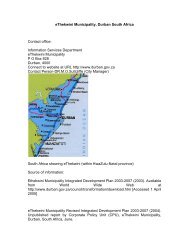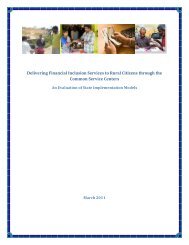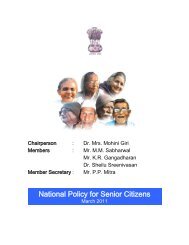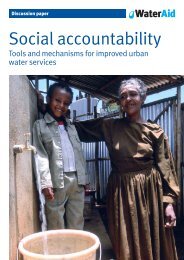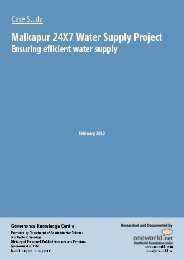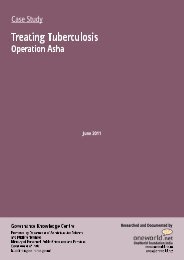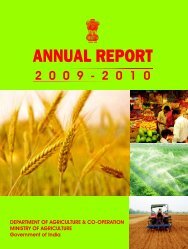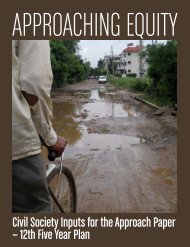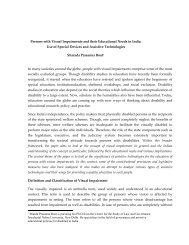Changing Framework of Local Governance and - Create
Changing Framework of Local Governance and - Create
Changing Framework of Local Governance and - Create
Create successful ePaper yourself
Turn your PDF publications into a flip-book with our unique Google optimized e-Paper software.
<strong>Changing</strong> <strong>Framework</strong> <strong>of</strong> <strong>Local</strong> <strong>Governance</strong> <strong>and</strong> Community Participation in Elementary Educationgovernment. Therefore, the approach has been one <strong>of</strong> cautious <strong>and</strong> gradual transformation.Actions have been initiated through two processes. On the one h<strong>and</strong>, significant powers <strong>and</strong>responsibilities have been delegated through executive orders <strong>of</strong> the State Department <strong>of</strong>Education to panchayat bodies at different levels - district, block <strong>and</strong> village levels. However,the state government is simultaneously moving ahead with comprehensive legislation totransfer the school education system to the control <strong>of</strong> the panchayat system. Such a dualapproach is being adopted, as most <strong>of</strong> the personnel in the schools are legal employees <strong>of</strong> thestate government. This dual track transformation is likely to continue until such time that thewhole system comes fully under the legal control <strong>of</strong> the local-self-government bodies. In orderto implement the local governance process, Village Education Committees have beenestablished involving the elected representatives <strong>of</strong> the local panchayat bodies along withother community <strong>and</strong> school representatives. Thus, the approach essentially consists <strong>of</strong>restructuring <strong>of</strong> the system through the top-down rewriting <strong>of</strong> the rulebook by the governmentbureaucracy, which subsequently gets legitimised through political <strong>and</strong> legislative processes.In relation to this, one <strong>of</strong> the important initiatives that was undertaken by the Madhya PradeshGovernment is the introduction <strong>of</strong> Jana Sikshan Adhiniyam 24 in 2002. This is an importantlegal framework for educational reform which seeks to strengthen institutional partnershipsbetween the government, local bodies <strong>and</strong> the community in the task <strong>of</strong> universal elementary<strong>and</strong> adult education promoting equity <strong>and</strong> quality. Whereas it legitimises involvement <strong>of</strong> localbodies like gram panchayat, panchayat samiti etc. whereas delegates some responsibilities toPTAs. As mentioned in the Human Development Report <strong>of</strong> Madhya Pradesh:The Act recognises the right <strong>of</strong> every child to basic education <strong>and</strong> seeks to removeimpediments to access <strong>and</strong> participation in schools both by improving delivery as wellas by creating social pressure. Parental responsibility for compulsory education up toage 14 is enforceable by Gram Sabha. Strengthening decentralization, the Act laysdown clearly the roles <strong>and</strong> responsibilities <strong>of</strong> key agencies: parents, teachers, localbodies <strong>and</strong> government. A crucial role is assigned to the PTA to be set up for everyschool (GoMP, 2002:25).Apart from all these, the Act also state that teachers are not to be normally deployed for nonteaching tasks <strong>and</strong> prior permission is not required to open schools up to the middle level. Inaddition, the Act also envisaged for development <strong>of</strong> jan siksha yojana 25 from PTA level.Education Funds (shiksha kosh) are also to be set up at the school, the district <strong>and</strong> the statelevels facilitating the mobilization <strong>of</strong> additional resources. Thus, this Act has facilitatedfinancial decentralization as well. A Public Education Report has to be presented to the PTA<strong>and</strong> District Government on a quarterly basis <strong>and</strong> to the legislative assembly. These reports areused for jan shiksha yojana. 26According to the Uttar Pradesh Panchayat Act <strong>of</strong> 1994 (The Uttar Pradesh <strong>Local</strong> SelfGovernment Laws (Amendment) Act 1994 passed by the legislature <strong>of</strong> UP to incorporate them<strong>and</strong>atory provisions <strong>of</strong> the CAA 1992), six committees have been created with specific roles<strong>and</strong> responsibilities to assist all three tiers <strong>of</strong> panchayat <strong>and</strong> education committee is one <strong>of</strong>these six committees (GoUP, 2006). The shiksha (education) committee:24 People Education Act in Madhya Pradesh25 People Education Plan26 People Education Plans23


